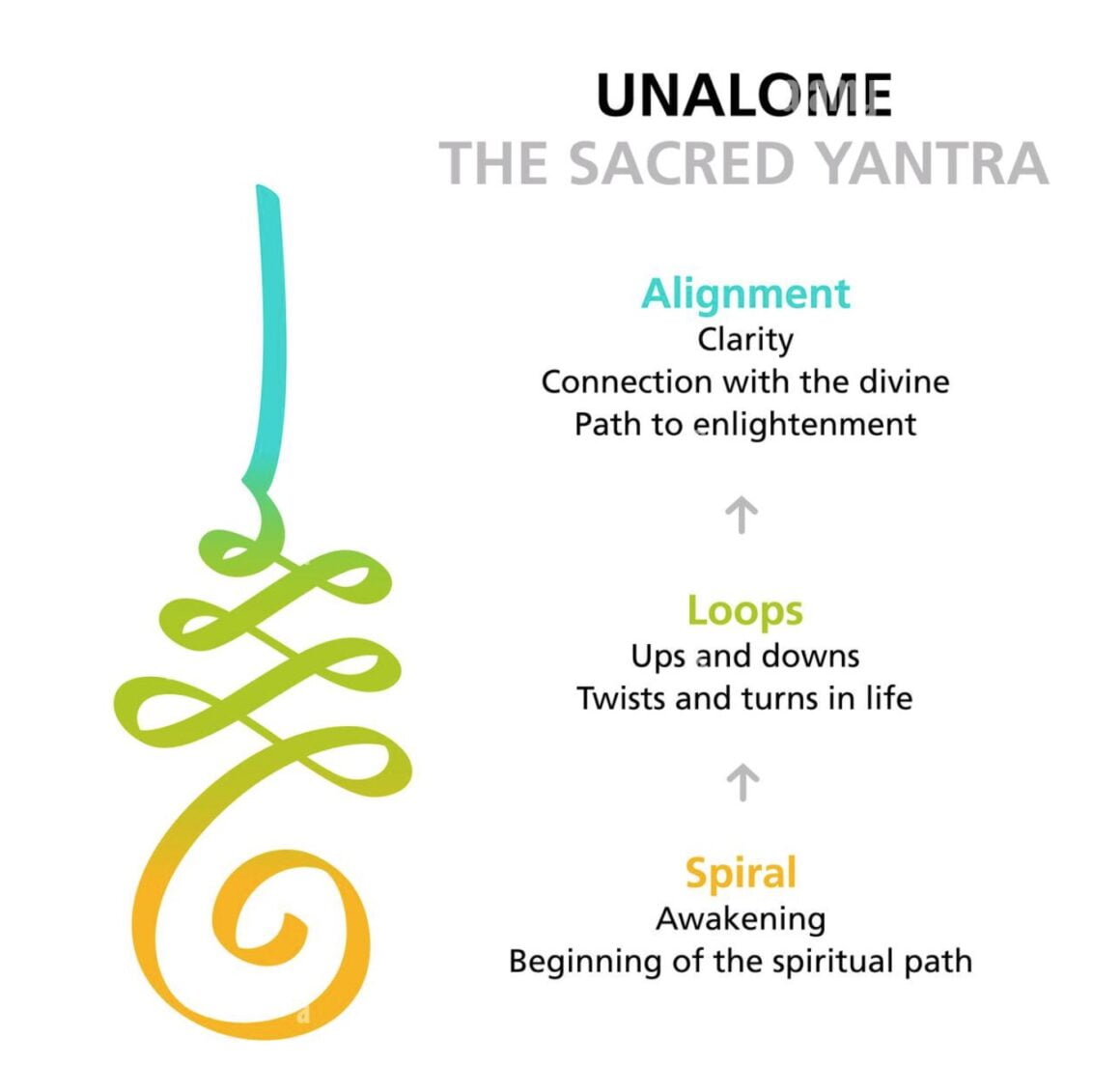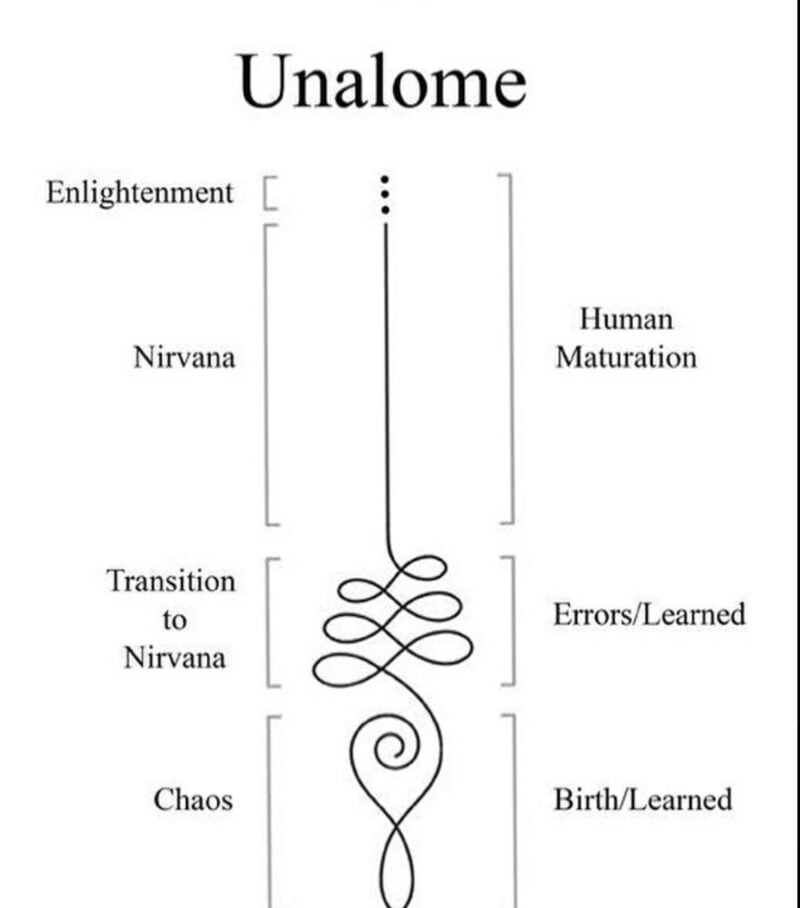The Unalome is a symbol rich in meaning and deeply rooted in Buddhist tradition. It represents the spiritual journey one takes throughout their life. At its core, the Unalome signifies the path towards enlightenment, mapping out the twists, turns, and obstacles encountered as one seeks to understand life’s mysteries. The iconography of the symbol is intentional; beginning with a spiral, it leads into a series of intertwining loops that eventually culminate in a straight line, alluding to the progressive unravelling of human ignorance and the attainment of wisdom.
Intricately linked to the theme of personal growth and enlightenment, the Unalome symbolically narrates the story of human consciousness evolving from a state of confusion to one of clarity. The base of the symbol or the spiral represents the start of the journey, typically seen as the beginning of one’s spiritual awakening. The twists and loops denote the various trials and experiences, while the straight path signifies the direct route to enlightenment which is achieved after learning from life’s lessons.
Adoption of the Unalome beyond its Buddhist origins demonstrates its universal appeal as a representation of the human quest for purpose and understanding. The symbol has found a place among diverse groups, including yoga practitioners and meditation enthusiasts, symbolizing not just a connection to the divine but also a guide for internal reflection and the pursuit of inner peace.
Origins of the Unalome
The Unalome is a spiritual symbol with its roots deeply planted in the religious traditions of Buddhism and Hinduism. It serves as a visual metaphor for the journey to enlightenment.
Buddhist Roots
In Buddhism, the Unalome represents the path each person takes throughout their life and the struggles of navigating through the complexities of existence. Historically, it is linked to the dharma, which embodies the Buddha’s teachings, and symbolizes the journey towards spiritual awakening and enlightenment. The spirals in the Unalome denote the twists and turns of life, while the straight line signifies reaching nirvana, the ultimate goal in Buddhism. The symbol is thought to be connected to the third eye of the Buddha, an emblem of spiritual insight and vision.
Hindu Influence
In the context of Hinduism, the Unalome similarly reflects the journey to enlightenment but integrates elements unique to the Hindu tradition, such as the importance of Lord Shiva and the sacred Om. Lord Shiva, one of the principal deities in Hinduism, embodies the role of the destroyer and rebuilder, resonating with the Unalome’s theme of life’s cyclical nature and evolution towards greater understanding. The visual similarity to the Om symbol, a sacred sound in Hinduism and a common element in yoga practices, ties the Unalome’s significance to the broader spiritual journey represented within Indian religions.

Symbolic Components of the Unalome
The Unalome symbol narrates the journey of life and the path to enlightenment, using distinct elements to illustrate stages of spiritual progression. Each component of the Unalome carries significant symbolism that aligns with a person’s path from birth to enlightenment.
The Spiral Base
At the starting point of the Unalome symbol is a spiral that signifies the birth of an individual into the world. This spiral encapsulates the initial unawareness and deeper connection to the self, which marks the beginning of one’s spiritual journey.
Twists and Turns
Proceeding from the spiral are twists and turns that represent the various challenges and obstacles one encounters in life. These struggles are intrinsic to the human experience and symbolize the complex journey that each person must navigate in search of meaning and truth.
The Straight Line
Emerging from the complexities is a straight line pointing upwards, illustrating the moment an individual finds clarity and purpose. This pivotal segment of the Unalome embodies the progress towards enlightenment and nirvana, reflective of one’s journey to enlightenment.
The Dot
At the very end of the Unalome rests a dot, symbolizing the culmination of the spiritual journey – the attainment of enlightenment. Often associated with death in a metaphorical sense, it signifies the end of one’s worldly journey and the achievement of nirvana. The dot can also be seen as the third eye chakra or crown chakra, signifying ultimate spiritual consciousness and union with the divine.

Incorporation in Body Art
Unalome tattoos have become a significant trend in body art, symbolizing personal and spiritual growth. The intricate design not only serves as a visual marker of one’s journey but also holds deep spiritual significance.
Unalome Tattoos
The Unalome tattoo is a representation of the journey to enlightenment, usually depicted as a spiraling path leading to a straight line, which signifies reaching Nirvana or a state of spiritual perfection. It is a physical expression of life’s twists and turns, reflecting that the path to enlightenment is not straight but is instead filled with obstacles and learning experiences. This body art is often chosen by individuals who are on a personal quest for truth and self-discovery.
Male and Female Unalome Designs
The Unalome design varies slightly between male and female depictions, touching on the nuances of masculine and feminine energies. Male Unalome tattoos are typically characterized by a straighter appearance in the last section of the design, signaling steadfastness and directness. In contrast, Female Unalome designs may incorporate more curves and ornate detailing, hinting towards a more intuitive and flexible journey. These designs embody the distinct journeys and energies associated with male and female spiritual experiences.
Unalome in Jewelry and Fashion
Unalome designs have made a significant imprint in the jewelry and fashion industry. The symbol’s intricate aesthetic, representing the journey to enlightenment, has become a sought-after motif for those seeking a connection to spirituality or wanting to make a personal statement through style.
Jewelry designers have embraced the Unalome, crafting pieces that range from delicate to bold. The symbol is found in various accessories such as:
- Necklaces: Often featuring the Unalome as a pendant.
- Earrings: Unalome designs may hang elegantly or be engraved into studs.
- Bracelets and Bangles: The motif wraps around the wrist, symbolizing the wearer’s path.
- Rings: Unalome symbols adorning rings serve as a subtle, constant reminder of personal growth.
In fashion, Unalome patterns have transcended beyond jewelry. Designers incorporate this symbol into:
- Clothing: As prints on t-shirts, dresses, and scarves.
- Tattoos: A permanent form of fashion, expressing one’s commitment to their personal journey.
- Embroidery: Adding a touch of uniqueness to plain garments.
The use of the Unalome symbol in fashion serves as more than just an adornment; it conveys a narrative of perseverance and individuality. Its presence in accessories and clothing alike allows individuals to showcase their dedication to personal enlightenment and their affinity for meaningful design.
When including Unalomes in fashion accessories, there’s often an emphasis on material quality and craftsmanship, ensuring the symbol’s sacredness is honored. Those wearing Unalome jewelry or fashion items carry with them a piece of symbolic wisdom, seamlessly blending ancient tradition with contemporary style.

Unalome in Daily Practices
The Unalome symbol serves as a powerful tool in guiding individuals on their spiritual path, influencing daily life through both practice and thought. It holds particular resonance within meditation and yoga, as well as encapsulates essential teachings of Buddhist philosophy.
Meditation and Yoga
In meditation and yoga practices, the Unalome symbol acts as a visual metaphor for one’s journey toward enlightenment. Practitioners often focus on the image of the Unalome during their sessions to aid in concentrating their thoughts and maintaining awareness of their breath and movements.
- Meditation: Individuals visualize the Unalome to center their thoughts, reflecting on its gradually straightening lines as a representation of their growing awareness and spiritual progression.
- Yoga: Within yoga practices, the symbol encourages participants to stay present and move with intention. It reminds them to face challenges gracefully and embrace the fluidity between poses, akin to life’s twists and turns.
Philosophical Teachings
The Unalome is deeply intertwined with the philosophical teachings of Buddhism, encompassing core aspects of wisdom and enlightenment. It stands as a guide for daily reflection, prompting one to ponder their actions and experiences on the road to spiritual growth.
- Wisdom: The symbol prompts practitioners to evaluate life’s lessons critically, thereby gaining insight and clarity on their paths.
- Teachings of the Buddha: It encapsulates the essence of the Buddha’s teachings by emphasizing the importance of understanding and overcoming earthly struggles to achieve a state of transcendent peace.
Reflecting on Unalome Symbolism
The Unalome is a spiritual compass guiding individuals through the maze of existence toward ultimate enlightenment. This intricate symbol encapsulates the journey through life’s tumultuous path, the quest for inner peace, and the attainment of a higher state of consciousness.

Journey to Enlightenment
The Unalome embodies the journey to enlightenment, representing the complex expedition from ignorance to awakening. It begins with a spiral that signifies the challenges and uncertainties at life’s commencement. As the spiral transitions into the twists and loops, it symbolizes the various lessons and struggles that one faces along the spiritual journey. This winding path is indicative of the trials that are essential in the pursuit of wisdom and self-discovery.
Embracing Life’s Journey
Central to the Unalome’s design is the acknowledgment and embracing of life’s journey with all its imperfections. The loops serve as a reminder that despite setbacks, continuous progress is achievable as one learns and grows. These periods of growth are crucial stages in striving for a more profound connection with our higher selves. As the path straightens, it mirrors the incremental alignment with inner peace and moral clarity, denoting the stages just preceding moksha or liberation.
Achieving Balance and Transcendence
Finally, reaching the straight line at the end of the symbol corresponds to achieving balance and transcendence. This part of the Unalome denotes breaking free from the cycle of rebirth and arriving at a state of higher consciousness. The dots at the very end stand as representations of moksha – a release from the corporeal realms into the spiritual. They mark the culmination of the arduous journey, where tranquility and enlightenment are attained, signifying the soul’s arrival at its eternal home.
Common Variations and Meanings
The Unalome is rich with variations, each carrying distinct meanings based on symbolism interwoven with other spiritual icons. These variations can significantly alter the symbol’s interpretation.
The Lotus and Unalome
The combination of the Unalome and the lotus flower is common in spiritual iconography. The lotus flower is symbolic of purity and awakening in the face of adversity, as it rises immaculate from muddy waters. Unalome lotus designs encapsulate this philosophy, illustrating the journey to enlightenment aligns with overcoming worldly struggles. Often depicted at the end of the Unalome’s spiral, it signifies the achievement of clarity and an enlightened state.
Other Unalome Combinations
Unalome symbols often incorporate additional elements, each introducing new dimensions of meaning:
- The Circle: Representing life’s continuum and the notion of infinite existence.
- The Spiral: Core of the Unalome, symbolizing the twists and turns of life’s journey.
- Yogic Symbols: When paired with symbols from yogic traditions, the Unalome can convey concepts tied to chakras or particular energies.
Yogis and those invested in spiritual practices may use these combinations to express their understanding of life, spiritual progress, or the intertwining of the physical with the spiritual.
Upside Down Unalome
An upside-down Unalome can be seen as controversial but is used by some to signify a life’s journey that is more individualistic, reflecting a path taken against traditional flows. It can also mean a quest for personal truth that goes against conventional wisdom, highlighting a rebellious or explorative spirit. This variation encourages an unconventional interpretation of the journey towards wisdom and enlightenment.
Unalome across Cultures
The Unalome symbol represents the journey to enlightenment across Buddhism and Hinduism, signifying the importance of overcoming life’s challenges and the value of resilience.
Historical Contexts
In Buddhism, the Unalome symbol originated as a representation of the life path individuals undertake, emphasizing the challenges and obstacles to be overcome on the way to enlightenment. The winding spiral of the Unalome can be seen as an embodiment of life’s trials, with the straight line signifying the reaching of enlightenment and the present moment of clarity and understanding.
Hinduism shares a very similar interpretation of the Unalome. It is often linked to the third-eye of Shiva, and reflects strength, resilience, and the spiritual journey that follows a person’s temporal experiences through various states of consciousness to ultimate liberation.
Contemporary Interpretations
The Unalome symbol has been embraced in Sak Yant tattooing, where it is often incorporated into larger designs to convey spiritual protection and the importance of overcoming life’s adversities. It’s a cultural adaptation that enforces personal meanings of spiritual growth and the constant process of learning and evolving.
Today, the Unalome continues to hold significance beyond its traditional contexts. It is used in contemporary art, jewelry, and mindfulness practices to symbolize a person’s journey toward the present moment, often associated with personal trials and the resilience needed to face them. It reminds practitioners of the impermanent nature of our experiences and the strength found in facing them with clarity.



